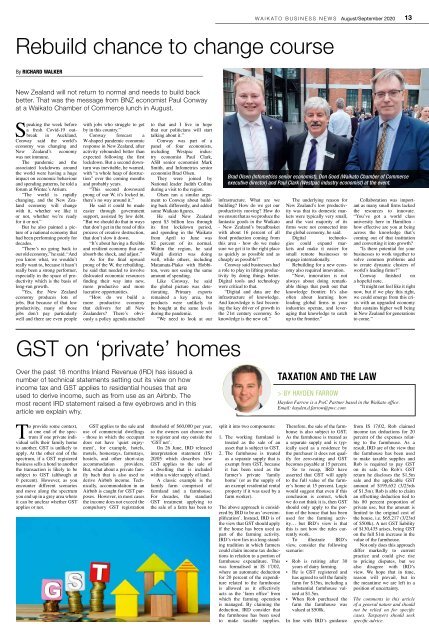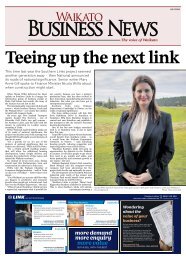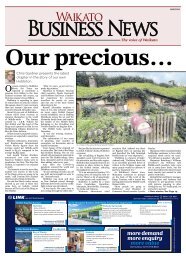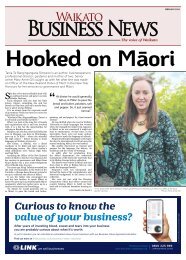Waikato Business News August/September 2020
Waikato Business News has for a quarter of a century been the voice of the region’s business community, a business community with a very real commitment to innovation and an ethos of co-operation.
Waikato Business News has for a quarter of a century been the voice of the region’s business community, a business community with a very real commitment to innovation and an ethos of co-operation.
You also want an ePaper? Increase the reach of your titles
YUMPU automatically turns print PDFs into web optimized ePapers that Google loves.
WAIKATO BUSINESS NEWS <strong>August</strong>/<strong>September</strong> <strong>2020</strong><br />
13<br />
Rebuild chance to change course<br />
By RICHARD WALKER<br />
New Zealand will not return to normal and needs to build back<br />
better. That was the message from BNZ economist Paul Conway<br />
at a <strong>Waikato</strong> Chamber of Commerce lunch in <strong>August</strong>.<br />
Speaking the week before<br />
a fresh Covid-19 outbreak<br />
in Auckland,<br />
Conway said the world’s<br />
economy was changing and<br />
New Zealand’s economy<br />
was not immune.<br />
The pandemic and the<br />
associated lockdowns around<br />
the world were having a huge<br />
impact on economic behaviour<br />
and spending patterns, he told a<br />
forum at Wintec’s Atrium.<br />
“The world is rapidly<br />
changing, and the New Zealand<br />
economy will change<br />
with it, whether we like it<br />
or not, whether we’re ready<br />
for it or not.”<br />
But he also painted a picture<br />
of a national economy that<br />
had been performing poorly for<br />
decades.<br />
“There’s no going back to<br />
our old economy,” he said. “And<br />
you know what, we wouldn’t<br />
really want to, because it hasn’t<br />
really been a strong performer,<br />
especially in the space of productivity<br />
which is the basis of<br />
long-run growth.<br />
“Yes, the New Zealand<br />
economy produces lots of<br />
jobs. But because of that low<br />
productivity, many of those<br />
jobs don’t pay particularly<br />
well and there are even people<br />
with jobs who struggle to get<br />
by in this country.”<br />
Conway forecast a<br />
W-shaped pandemic economic<br />
response in New Zealand, after<br />
activity rebounded better than<br />
expected following the first<br />
lockdown. But a second downturn<br />
was inevitable, he warned,<br />
with “a whole heap of destruction”<br />
over the coming months<br />
and probably years.<br />
“This second downward<br />
prong of our W, it’s locked in,<br />
there’s no way around it.”<br />
He said it could be made<br />
easier through government<br />
support, assisted by low debt.<br />
“But we should do that in ways<br />
that don’t get in the road of this<br />
process of creative destruction,<br />
that don’t slow it down.<br />
“It’s about having a flexible<br />
and resilient economy that can<br />
absorb the shock, and adjust.”<br />
As for the final upward<br />
prong of the W, the rebuilding,<br />
he said that needed to involve<br />
dislocated economic resources<br />
finding their way into new,<br />
more productive and more<br />
lucrative opportunities.<br />
“How do we build a<br />
more productive economy<br />
that delivers for all New<br />
Zealanders? There’s obviously<br />
a policy agenda attached<br />
to that and I live in hope<br />
that our politicians will start<br />
talking about it.”<br />
Conway was part of a<br />
panel of four economists,<br />
including Westpac industry<br />
economist Paul Clark,<br />
ASB senior economist Mark<br />
Smith, and Infometrics senior<br />
economist Brad Olsen.<br />
They were joined by<br />
National leader Judith Collins<br />
during a visit to the region.<br />
Olsen ran a similar argument<br />
to Conway about building<br />
back differently, and added<br />
some <strong>Waikato</strong> figures.<br />
He said New Zealand<br />
spent $3 billion less through<br />
its first lockdown period,<br />
and spending in the <strong>Waikato</strong><br />
from April to June was<br />
82 percent of its normal.<br />
Within the region, he said<br />
Waipā district was doing<br />
well, while others, including<br />
Matamata-Piako with Hobbiton,<br />
were not seeing the same<br />
amount of spending.<br />
Like Conway, he said<br />
the global picture was deteriorating.<br />
Primary exports<br />
remained a key area, but<br />
products were unlikely to<br />
be bought at the same levels<br />
during the pandemic.<br />
“We need to look at our<br />
Brad Olsen (Infometrics senior economist), Don Good (<strong>Waikato</strong> Chamber of Commerce<br />
executive director) and Paul Clark (Westpac industry economist) at the event.<br />
infrastructure. What are we<br />
building? How do we get our<br />
productivity moving? How do<br />
we ensure that as we produce the<br />
fantastic goods in the <strong>Waikato</strong><br />
- New Zealand’s breadbasket<br />
with about 16 percent of all<br />
food production coming from<br />
this area - how do we make<br />
sure we get it to the right place<br />
as quickly as possible and as<br />
cheaply as possible?”<br />
Conway said businesses had<br />
a role to play in lifting productivity<br />
by doing things better.<br />
Digital tools and technology<br />
were critical to that.<br />
“Digital and data are the<br />
infrastructure of knowledge.<br />
And knowledge is fast becoming<br />
the key driver of growth in<br />
the 21st century economy. So<br />
knowledge is the new oil.”<br />
The underlying reason for<br />
New Zealand’s low productivity<br />
was that its domestic markets<br />
were typically very small,<br />
and the vast majority of its<br />
firms were not connected into<br />
the global economy, he said.<br />
Digital technologies<br />
could expand markets<br />
and make it easier for<br />
small remote businesses to<br />
engage internationally.<br />
Rebuilding for a new economy<br />
also required innovation.<br />
“Now, innovation is not<br />
always about doing remarkable<br />
things that push out that<br />
knowledge frontier. It’s also<br />
often about learning how<br />
leading global firms in your<br />
industries operate, and leveraging<br />
that knowledge to catch<br />
up to the frontier.”<br />
Collaboration was important<br />
as many small firms lacked<br />
the resources to innovate.<br />
“You’ve got a world class<br />
university here in Hamilton -<br />
how effective are you at being<br />
across the knowledge that’s<br />
coming out of that institution<br />
and converting it into growth?<br />
“Is there potential for your<br />
businesses to work together to<br />
solve common problems and<br />
to create dynamic clusters of<br />
world’s leading firms?”<br />
Conway finished on<br />
a hopeful note.<br />
“It might not feel like it right<br />
now, but if we play this right,<br />
we could emerge from this crisis<br />
with an upgraded economy<br />
that sustains higher well being<br />
in New Zealand for generations<br />
to come.”<br />
GST on ‘private’ homes<br />
Over the past 18 months Inland Revenue (IRD) has issued a<br />
number of technical statements setting out its view on how<br />
income tax and GST applies to residential houses that are<br />
used to derive income, such as from use as an Airbnb. The<br />
most recent IRD statement raised a few eyebrows and in this<br />
article we explain why.<br />
TAXATION AND THE LAW<br />
> BY HAYDEN FARROW<br />
Hayden Farrow is a PwC Partner based in the <strong>Waikato</strong> office.<br />
Email: hayden.d.farrow@pwc.com<br />
To provide some context,<br />
at one end of the spectrum<br />
if one private individual<br />
sells their family home<br />
to another, GST is unlikely to<br />
apply. At the other end of the<br />
spectrum, if a GST registered<br />
business sells a hotel to another<br />
the transaction is likely to be<br />
subject to GST (although at<br />
0 percent). However, as you<br />
encounter different scenarios<br />
and move along the spectrum<br />
you end up in a grey area where<br />
it can be unclear whether GST<br />
applies or not.<br />
GST applies to the sale and<br />
use of commercial dwellings<br />
- those in which the occupant<br />
does not have ’quiet enjoyment’,<br />
for example, hotels,<br />
motels, homestays, farmstays,<br />
hostels, and other short-stay<br />
accommodation providers.<br />
But, what about a private family<br />
bach that is also used to<br />
derive Airbnb income. Technically,<br />
accommodation in an<br />
Airbnb is caught for GST purposes.<br />
However, in most cases<br />
the income does not exceed the<br />
compulsory GST registration<br />
threshold of $60,000 per year,<br />
so the owners can choose not<br />
to register and stay outside the<br />
‘GST net’.<br />
On 26 June, IRD released<br />
interpretation statement (IS)<br />
20/05 which describes how<br />
GST applies to the sale of<br />
a dwelling that is included<br />
within a wider supply of land.<br />
A classic example is the<br />
family farm comprised of<br />
farmland and a farmhouse.<br />
For decades, the standard<br />
GST treatment applying to<br />
the sale of a farm has been to<br />
split it into two components:<br />
1. The working farmland is<br />
treated as the sale of an<br />
asset that is subject to GST.<br />
2. The farmhouse is treated<br />
as a separate supply that is<br />
exempt from GST, because<br />
it has been used as the<br />
farmer’s private ‘family<br />
home’ (or as the supply of<br />
an exempt residential rental<br />
property if it was used by a<br />
farm worker).<br />
The above approach is considered<br />
by IRD to be an ‘oversimplification’.<br />
Instead, IRD is of<br />
the view that GST should apply<br />
if the house has been used as<br />
part of the farming activity.<br />
IRD’s view lies in a long-standing<br />
tradition in which farmers<br />
could claim income tax deductions<br />
in relation to a portion of<br />
farmhouse expenditure. This<br />
was formalised in IS 17/02,<br />
where an automatic deduction<br />
for 20 percent of the expenditure<br />
related to the farmhouse<br />
is allowed as it effectively<br />
acts as the ’farm office’ from<br />
which the farming operation<br />
is managed. By claiming the<br />
deduction, IRD consider that<br />
the farmhouse has been used<br />
to make taxable supplies.<br />
Therefore, the sale of the farmhouse<br />
is also subject to GST.<br />
As the farmhouse is treated as<br />
a separate supply and is typically<br />
used as a residence by<br />
the purchaser it does not qualify<br />
for zero-rating and GST<br />
becomes payable at 15 percent.<br />
So to recap, IRD have<br />
asserted that GST will apply<br />
to the full value of the farmer’s<br />
home at 15 percent. Logic<br />
would suggest that even if this<br />
conclusion is correct, which<br />
we do not think it is, then GST<br />
should only apply to the portion<br />
of the house that has been<br />
used for the farming activity…<br />
but IRD’s view is that<br />
this is not how the rules currently<br />
work.<br />
To illustrate IRD’s<br />
view, consider the following<br />
scenario:<br />
• Rob is retiring after 30<br />
years of dairy farming.<br />
• He is GST registered and<br />
has agreed to sell the family<br />
farm for $15m, including a<br />
substantial farmhouse valued<br />
at $1.5m.<br />
• When Rob purchased the<br />
farm the farmhouse was<br />
valued at $500k.<br />
In line with IRD’s guidance<br />
from IS 17/02, Rob claimed<br />
income tax deductions for 20<br />
percent of the expenses relating<br />
to the farmhouse. As a<br />
result, IRD are of the view that<br />
the farmhouse has been used<br />
to make taxable supplies and<br />
Rob is required to pay GST<br />
on its sale. On Rob’s GST<br />
return he discloses the $1.5m<br />
sale and the applicable GST<br />
amount of $195,652 (3/23rds<br />
of $1.5m). Rob is able to claim<br />
an offsetting deduction tied to<br />
his 80 percent proportion of<br />
private use, but the amount is<br />
limited to the original cost of<br />
the house, i.e. $65,217 (3/23rd<br />
of $500k). A net GST liability<br />
of $130,435 arises, being GST<br />
on the full $1m increase in the<br />
value of the farmhouse.<br />
Not only does this approach<br />
differ markedly to current<br />
practice and could give rise<br />
to pricing disputes, but we<br />
also disagree with IRD’s<br />
view. We hope that in time,<br />
reason will prevail, but in<br />
the meantime we are left in a<br />
position of uncertainty.<br />
The comments in this article<br />
of a general nature and should<br />
not be relied on for specific<br />
cases. Taxpayers should seek<br />
specific advice.


















